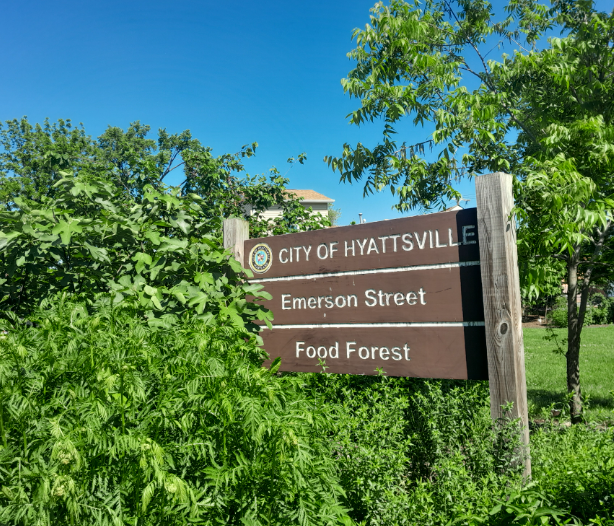Imke Alf-Wien
Whenever I visited Hyattsville’s two food forests in April and May this year, I found myself alone. I felt like an intruder while plucking a few leaves from a large clump of fleshy sorrel or harvesting stalks of seemingly untouched sea kale.
Didn’t anyone realize that the produce was, in fact, free and available to everyone? According to the city’s website, both the Emerson Street and McClanahan food forests are “open year-round for community members to pick seasonally available fruits and vegetables.” So where were all those community members?
 At Emerson Street Food Forest, you’ll find mulberries in season, along with blueberries, strawberries, blackberries, serviceberries, jostaberries, elderberries, currants and more.
At Emerson Street Food Forest, you’ll find mulberries in season, along with blueberries, strawberries, blackberries, serviceberries, jostaberries, elderberries, currants and more.
On an overcast May morning, Dawn Taft, an arborist and environmental programs manager in Hyattsville, gave me a tour of the Emerson Street Food Forest at 4515 Emerson St. She was excited to see how good the forest was: The flower beds were well mulched, the grass was freshly cut, and the first mulberries and strawberries would soon be ready for harvest.
The Emerson Street Food Forest, located near Alternate Route 1, was started by former Hyattsville Mayor Candace Hollingsworth and opened in 2016. Taft explained that the goal was to bring the community together in a safe place. The plan has far exceeded her expectations, helping to revitalize the area. She said she especially enjoys seeing families gather there on summer days, juice dripping from children’s mouths from freshly picked berries.
Dozens of edible plants are grown here, without chemicals, and with the help of pollinators. I counted eight kinds of berries, including mulberries, blueberries, strawberries, blackberries, serviceberries, jostaberries, elderberries, and currants; several kinds of nuts, including pecans, walnuts, and hazelnuts; apples, cherries, figs, pawpaws, pears, persimmons, and pomegranates. Even Taft’s greatest pride, kiwifruit, is producing tiny fruits for the first time. Sorrel and sea kale cover much of the ground. Most of the edible plants have name tags and QR codes that allow visitors to look up basic information, such as quick cooking ideas and the months when the plants ripen.
Conveniently located at the intersection of Oliver Street and Jamestown Road in West Hyattsville, near the Hyattsville Crossing Metro station, the McClanahan Food Forest is much smaller than Emerson and has a living room feel, Taft said. There are benches where visitors can take their time, enjoy the greenery and pick produce, including sea kale and several types of berries.
 Most of the edible plants in the city’s two edible forests are equipped with name tags and QR codes that allow visitors to look up basic information such as quick cooking ideas and the month in which the plants ripen.
Most of the edible plants in the city’s two edible forests are equipped with name tags and QR codes that allow visitors to look up basic information such as quick cooking ideas and the month in which the plants ripen.
Photo credit: Imke Alf Wien
Food forests, also known as “woodland gardens” or “edible forests,” have been around for thousands of years. From Mesoamerica to Mesopotamia to Rome, these “food landscapes” were often incorporated into palace and villa gardens, but the concept of bringing them to urban areas is fairly new. Food forests are part of a national trend to increase food security, availability, and accessibility, and promote sustainability and healthy lifestyles. According to an April 2023 article in The Conversation, more than 85 community food forest initiatives can be found across the United States.
Neighbors of the Emerson Street Food Forest praise the food forest and the impact it has on the community.
Freddie Reed, whose family has owned the adjacent property since the 1970s, still remembers when it was empty and dismal. Now the property is well-used, he said, and he especially enjoys watching children care for it while playing ball, picking berries and climbing trees.
Romi Singh, who has rented an auto repair and body shop on Emerson Avenue for 15 years, said he has noticed customers enjoying the quiet of the park while waiting for their cars to be serviced. Recently, one customer told him how happy they were to be able to look up information about edible plants in the food forest on their phone.
Wouldn’t it be great if more people could take advantage of the quiet space of Hyattsville Food Forest to gather, chat, play, and even pick produce to add to the dinner table? The recipes above not only offer some inspiration for how to use the abundant berries, but are simple enough for chefs of all ages.
Berries are not only delicious, they’re also packed with antioxidants and fiber. You can use any red, purple, or pink berries or any combination of berries in this pudding. I used fresh mulberries and strawberries, but frozen berries would also work.
material:
1 cup diced mulberries
1 cup diced strawberries
1 tablespoon maple syrup
1 cup brown sugar (divided)
4 tablespoons room temperature butter
Whole Milk Cup
1 teaspoon vanilla extract
1 cup all-purpose or gluten-free flour
1 teaspoon baking powder
1 teaspoon salt
1 tablespoon cornstarch
cup of boiling water
direction:
Preheat oven to 375 degrees and grease an 8 x 8 inch square baking dish. Add berries and drizzle with maple syrup.
Place dish on baking sheet. In a large bowl, whisk 1 cup brown sugar and 1 cup butter until fluffy. Add milk and vanilla and mix well. Add flour, baking powder, and salt and mix until ingredients are combined. Spoon batter over fruit, spreading evenly up the sides. Mix remaining 1 cup brown sugar and cornstarch and sprinkle over batter. Gently pour boiling water over mixture. Do not stir. Bake for 35 to 40 minutes or until golden crust forms. Serve warm.
Imke Ahlf-Wien is a nutrition educator with a passion for fresh, locally grown food.


